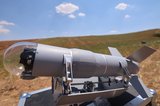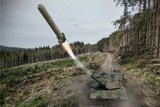DroneShield unveils new DoD-tested ruggedised tactical controller
The DroneSentry-C2T tablet has been designed for forward operations. (Photo: DroneShield)
Australian company DroneShield has developed an improved version of its C2 system used to operate it vehicle-mounted or static DroneSentry system. The company said worldwide demand for C2 systems was increasing and that the new tablet controller had been trialled by the US Department of Defense (DoD).
DroneSentry-C2 Tactical (DroneSentry-C2T) has been described by its manufacturer ‘as a ruggedised, on-the-edge version of DroneShield’s main DroneSentry-C2 [which] provides operators with real-time C-UAS situational awareness from a single device or network of DroneShield’.
‘[It also operates with] third-party devices, such as the RfPatrol Mk2 body worn drone detector and the DroneSentry-X on-the-move and expeditionary fixed site drone detection and defeat system.’
The C2T can provide satellite map-based display with two-way communication between the user and the distributed network of counter-drone devices, demonstrating drone detections from a network of sensors back to a central point anywhere to a rugged user tablet accompanied by defeat capability.
Angus Bean, CTO at DroneShield, said ‘it allows personnel on the ground to take a more strategic view of the area of operation’.
‘As we are seeing in Ukraine and other places around the world, handheld C-UAS devices enable cost-effective, mass-scale drone detection and defeat capability [and] DroneSentry-C2T enables to network these groups of devices together, without a limitation on size of the amount of devices,’ Bean claimed.
DroneShield has sold systems to the US, Brazil and Australia, with systems also supplied to Ukraine.
More from Land Warfare
-
![Dedicated drone munitions could unlock modular mission potential]()
Dedicated drone munitions could unlock modular mission potential
Top attacks have proven effective against heavily armoured vehicles in Ukraine. A new family of uncrewed aerial system-delivered munitions is looking to press that advantage further.
-
![Elbit bets on local content for US howitzer bid as it faces off against popular systems]()
Elbit bets on local content for US howitzer bid as it faces off against popular systems
The Israeli company hopes that producing its Sigma artillery system wholly in the US will help it win a key US Army contract, but it will be up against the popular CAESAR Mk II wheeled weapon and the K9 tracked.
-
![Germany orders 84 Boxer howitzers as UK commits to a single demonstrator]()
Germany orders 84 Boxer howitzers as UK commits to a single demonstrator
Germany has ordered 84 RCH 155 self-propelled guns, as system incorporating Boxer 8×8 vehicles and the Artillery Gun Module, and 200 Puma Infantry Fighting Vehicles while the UK has committed to a single Early Capability Demonstrator RCH 155.
-
![Companies look to tank-launched guided projectiles for non-line-of-sight effects]()
Companies look to tank-launched guided projectiles for non-line-of-sight effects
While integration of guided weapons on modern armoured vehicles usually takes the form of a podded launcher on the turret exterior, recent developments suggest the concept of firing missiles from a tank’s main gun could be seeing a revival.
-
![Germany signs multi-billion-dollar deals for 6x6 CAVS and GDELS Eagle vehicles]()
Germany signs multi-billion-dollar deals for 6x6 CAVS and GDELS Eagle vehicles
The order is a further boost for the Common Armoured Vehicles System programme which has notched notable successes in the past 12 months. The first vehicle, made in Finland, will be delivered next year with local production expected to ramp up in 2027.
-
![Rheinmetall and KNDS tank tie-up narrows trans-European options]()
Rheinmetall and KNDS tank tie-up narrows trans-European options
The French and German governments signed an agreement in June 2018 to cooperate on the development of a new main battle tank under the Main Ground Combat System programme but the effort has struggled. This new agreement may damage it further.
























